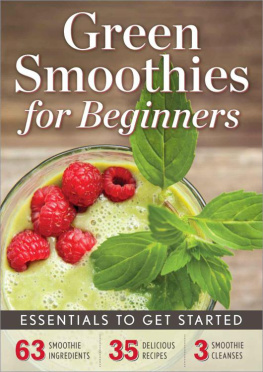Diana Rosen - Green Tea: Antioxidants in a Cup
Here you can read online Diana Rosen - Green Tea: Antioxidants in a Cup full text of the book (entire story) in english for free. Download pdf and epub, get meaning, cover and reviews about this ebook. year: 2000, publisher: Storey Publishing, LLC, genre: Home and family. Description of the work, (preface) as well as reviews are available. Best literature library LitArk.com created for fans of good reading and offers a wide selection of genres:
Romance novel
Science fiction
Adventure
Detective
Science
History
Home and family
Prose
Art
Politics
Computer
Non-fiction
Religion
Business
Children
Humor
Choose a favorite category and find really read worthwhile books. Enjoy immersion in the world of imagination, feel the emotions of the characters or learn something new for yourself, make an fascinating discovery.

- Book:Green Tea: Antioxidants in a Cup
- Author:
- Publisher:Storey Publishing, LLC
- Genre:
- Year:2000
- Rating:3 / 5
- Favourites:Add to favourites
- Your mark:
- 60
- 1
- 2
- 3
- 4
- 5
Green Tea: Antioxidants in a Cup: summary, description and annotation
We offer to read an annotation, description, summary or preface (depends on what the author of the book "Green Tea: Antioxidants in a Cup" wrote himself). If you haven't found the necessary information about the book — write in the comments, we will try to find it.
- Lowers the risk of cancer
- Lowers the risk of cardiovascular disease
- Improves dental health and bone density
- Improves the fight against flus and other viral diseases
- Prevents infection
- Strengthens capillaries
- Reduces cholesterol
- Is a natural diuretic
- Is refreshing and relaxing
- Helps focus and stimulates thinking
- Tastes great
Green Tea: Antioxidants in a Cup — read online for free the complete book (whole text) full work
Below is the text of the book, divided by pages. System saving the place of the last page read, allows you to conveniently read the book "Green Tea: Antioxidants in a Cup" online for free, without having to search again every time where you left off. Put a bookmark, and you can go to the page where you finished reading at any time.
Font size:
Interval:
Bookmark:
Antioxidants in a Cup
Adapted from The Book of Green Tea,
by Diana Rosen

I began my life in tea as most North Americans do, thinking of real tea as that golden red-brown liquid into which one pours a dollop of milk and a spoonful or more of sugar. As my circle of tea acquaintances grew, I was introduced to tea plain, and my appreciation grew to embrace the briskness of a Ceylon, the dark sweetness of a Yunnan black, the complexity of a genuine single-estate Darjeeling.
With great fortune, my first experiences with green tea were ideal, for I was introduced by an avid and experienced Chinese teaman who served me in his own authentic Chinese teahouse. Tea was offered in a covered cup, curved slightly inward to fit even the smallest hands and placed atop a matching saucer that kept the hot cup from harming the hands. A domed lid was used as a paddle to push the fresh green leaves back and forth until they gave up their sweetness and provided me with their ambrosial nectar.
I was in love. I quickly and enthusiastically embraced the Chinese styles of preparation, acquiring the accoutrements one by one until my tea cabinet was full of their beauty.
The more I drank green tea, the more appreciative I was. The more varieties I experienced, the more astonished I became that this innocent leaf could be dried, steamed, or lightly pan-fired, and shaped in countless ways, always with the same result pure pleasure. It was easy to understand the teamans demands for beauty both in the dried state and in the infused leaf.
The Chinese greet friends with, Have you leisure time to have tea with me? The result will be relaxed, happy hours drinking your favorite teas while talking, perhaps engaging in a clattering mah-jongg game or listening to finches chirp sweetly as they swing in bamboo cages hanging from the ceiling of the teahouse. If you are really fortunate, you may stumble into a teahouse where traditional storytellers spin their centuries-old tales, which are sometimes more intoxicating than wine!
For the Japanese, green tea is an everyday pleasure drunk with morning rice (or even poured over it), served with other meals and to visitors, and, on important occasions, served much more elegantly at the formal tea ceremony called chanoyu. This way of tea never ceases to transport me, to offer a long-lasting spiritual vacation, to take me to a place of calm and serene attitude that derives solely from watching the ballet of chanoyu, in which the simplicity of water and leaf is elevated to pure art.
For the Vietnamese, Indonesians, and those in other tea-growing countries in the Pacific Rim, green tea is the everyday tea, ranging from the straightforward, even blunt taste of a roughly processed green to that world of savoring just beyond exquisite that comes from drinking the most cherished, most tenderly handled teas in the world.
To the Nepalese, Indians, and Sri Lankans, especially those dedicated to organic tea farming, their green teas bring many health-giving properties and nearly infinite tasting pleasures, without sacrificing the indescribable qualities that make the Nepalese, Indian, and Ceylonese teas endlessly satisfying to the palate.
The Ten Virtues of Tea
Myo-ei Shonin of Togano-o once wrote on his kettle what he considered the virtues of tea:
. Has the blessing of all the deities
. Promotes filial piety
. Drives away the devil
. Banishes drowsiness
. Keeps the five viscera* in harmony
. Wards off disease
. Strengthens friendships
. Disciplines body and mind
. Destroys passions
. Gives a peaceful death
*The liver is said to like acid taste, the lungs pungent, the heart bitter, the spleen sweet, and the kidneys salt.
Happily, I can say that not only is tea enjoyable, its good for you. For centuries, China has praised the health benefits of its native plant. Scientists around the world have researched and examined the leaf exhaustively, and they feel now that they know some of the reasons this simple beverage does so much. Tea provides benefits for bones and teeth. Its vital chemical compounds have been found to fight cancer, help stabilize diabetes, and do much to prevent cardiovascular disease. Tea can even make your skin healthier and prettier.
And the most beneficial, most healthful tea is the barely processed leaf from the Camellia sinensis bush green tea.
How does a brew from one plant do so much? That is our story. May it bring you information pure and simple, and pleasures small and great.
One cup does all disorders cure; with two your troubles will be fewer; three to the bones more vigor give; with four forever you will live as young as on your day of birth, a true immemorial on the earth.
For thousands of years, healers and monks have noted the many benefits of tea, particularly green tea its ability to offer refreshment, increase alertness, and stave off disease.Yet it is reassuring to know that pharmacologists, chemists, physicians, nutritionists, and others in the field of health science are recognizing the health-giving properties of tea when used consistently all through life.
Studies of teas value to maintaining good health have been reported in medical journals throughout the world. Most notable have been studies conducted by the Journal of the Japanese Society of Food Science and Technology, Tufts University, Harvard University, the National Cancer Institute, and U.S. teaching hospitals such as Johns Hopkins and Reed College. All of these studies concur on one point: Green tea is an inexpensive, healthful drink with possible long-range benefits, especially if taken daily throughout ones life.
The studies suggest that green tea may help lower the risk of cancer, inhibit aging, reduce the risk of cardiovascular disease, help lower blood-sugar levels, fight viral infections, and even prevent cavities, bad breath, and gum disease. While drinking green tea will certainly cause no harm, the best reason to drink it is that it does have time-tested benefits such as antioxidation of fats and possible anti-cancer properties.
Fighting Free Radicals
Excerpted from Rosemary Gladstars Herbs for Longevity & Well-Being, by Rosemary Gladstar (Storey Books, 1999)
Studies have shown that more than 60 major disorders and possibly even aging itself have the same cause: oxidation, or free-radical formation. Free radicals occur when cellular atoms break down, losing electrons in the process. In an attempt to stay balanced, a free radical borrows an electron from a neighboring atom, which in turn also borrows from a neighboring atom, setting up a cascading effect of electron thievery that can erode cell membranes and alter genetic material through oxidation, ultimately causing the breakdown of cells and tissues.
Free radicals are formed as part of the bodys normal metabolic process and perform a number of important activities that promote well-being. They help keep inflammation in check, fight bacteria, and regulate normal activity of the blood vessels and organs by keeping the smooth muscles in tone. However, daily exposure to stress and irritants from pollution and cigarette smoke to poor dietary choices and electromagnetic fields stimulates the body to produce an overabundance of free radicals.
Antioxidants are chemicals produced by the body to keep free radicals in check. They accomplish this by circulating throughout the system and neutralizing unpaired electrons, rendering them inactive. However, if the body is unable to produce enough antioxidants to meet the demands caused by excessive stress factors, free radicals continue to multiply, increasing the susceptibility to illness.
Font size:
Interval:
Bookmark:
Similar books «Green Tea: Antioxidants in a Cup»
Look at similar books to Green Tea: Antioxidants in a Cup. We have selected literature similar in name and meaning in the hope of providing readers with more options to find new, interesting, not yet read works.
Discussion, reviews of the book Green Tea: Antioxidants in a Cup and just readers' own opinions. Leave your comments, write what you think about the work, its meaning or the main characters. Specify what exactly you liked and what you didn't like, and why you think so.










